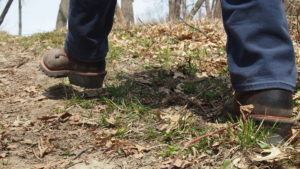John Muir and Our National Parks
 “The tendency nowadays to wander in wildernesses is delightful to see. Thousands of tired, nerve-shaken, over-civilized people are beginning to find out that going to the mountains is going home; that wildness is a necessity; and that mountain parks and reservations are useful not only as fountains of timber and irrigating rivers, but as fountains of life.”
“The tendency nowadays to wander in wildernesses is delightful to see. Thousands of tired, nerve-shaken, over-civilized people are beginning to find out that going to the mountains is going home; that wildness is a necessity; and that mountain parks and reservations are useful not only as fountains of timber and irrigating rivers, but as fountains of life.”
– John Muir
This week, April 18-26, marks National Park Week. And April 21 will mark the anniversary of the birth of John Muir, our country’s secular saint of the wilderness and founding father of our public lands.
Born in Scotland, Muir moved to Wisconsin with his family when he was eleven. A youth full of curiosity and invention led him to study at the University of Wisconsin, where he stayed for 3 years before moving on, traveling and finding work here and there around Canada and the northern US.
After a frightful injury that left him temporarily blinded for several weeks when he was nearing thirty, Muir began traveling again upon regaining his sight. He headed south through Florida, Cuba, across Panama, and then back north to California and the west coast, where he found his calling and eventually his home.
Muir’s travels and lifestyle allowed him to immerse himself in nature, spiritually in tune with the wilderness in a way most of us can never experience. He did, however, write copiously about these places, animals, and plants that he loved in stirring prose that inspired not only his contemporary readers but also kindred spirits over a century later. His work gives us insight not only into the closing frontier wilderness, with its spectacular landscapes and dramatic natural history, but also into his philosophy of nature as something transcendent, worthy of respect and devotion for its own sake, not simply for the bounty that the country’s individuals and industry could reap from it.
In his life he had seen the damage caused to pristine landscapes by commerce and industry for the sole benefit of humans—grazing sheep, timber harvests, damming rivers—and rejected the idea that these wild places could be exploited without ruining their special character. His writings helped inspire Congress to declare several of our most dramatic natural treasures National Parks in the late 19th century, including Sequoia and Muir’s beloved Yosemite, both established in 1890.
Muir was also the founding president of the Sierra Club, created in 1892 to protect and support the Sierra Nevada and establish other national parks. The Sierra Club, in turn, helped promote the creation of the National Park Service in 1916, which now oversees the 62 existing national parks as well as hundreds of related historic sites, preserves, monuments, and recreation areas.
We owe a debt to this remarkable man, who lived a remarkable life, and helped show the United States the importance of our natural heritage. He fought the pressures of industry, with its unrelenting quest to extract profit from our land, and helped show a young country the necessity of preserving itself, for itself and for future generations.
Although we can’t go visit our favorite parks at the moment, the amazing NPS has made many of them available virtually. Visit your favorite virtual National Park and take a moment to appreciate the legacy preserved for us through the actions of John Muir and the many dedicated people who worked alongside him and after him to understood what truly makes America great.
Originally posted in Sycamore Greenway Friends.


